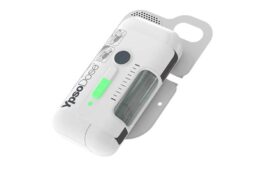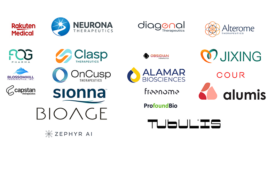Retinoic acid receptor-related orphan receptor gamma t (RORγt) inhibitors are currently in development for various indications. RORγt plays a crucial role in driving T helper 17 (Th17) differentiation and interleukin 17 (IL-17) expression. In homeostasis, these cells play a vital role in the defense against bacteria and fungi. However, this cell type seems to be dysregulated in many autoimmune diseases such as psoriasis, multiple sclerosis and others. In recent years, the focus has been on psoriasis, but other autoimmune and inflammatory diseases such as chronic obstructive pulmonary disease (COPD), inflammatory bowel disease (IBD) and dry eye disease are also of interest. Finally, one study is being conducted on castration-resistant prostate cancer.
The nuclear receptor RORγt
RORγt is the shorter isoform of the retinoic acid receptor-related orphan receptor gamma (RORγ, NR1F3). It belongs to the nuclear receptor (NR) superfamily, discovered in 1998, about four years later than RORγ. RORγ is ubiquitously expressed and associated with circadian rhythm-related gene expression regulation, gluconeogenesis, insulin sensitivity and lipid metabolism. Conversely, the expression of RORγt is highly selective and was first detected in thymocytes. Later research showed that it is also present in Th17 cells, CD8+ T 17 (Tc17) cells, γδT cells, tissue-resident T cells, lymphoid tissue inducer (LTi) cells, mucosal-associated invariant T (MAIT) cells and that it is a transcription factor of the cytokine IL-17. Expression regulation of the two isoforms has not been completely elucidated. RORγt is either a result of alternative splicing or, as shown by Ruan et al. (2011), due to an alternative promotor site.
The current RORγt treatment landscape
In psoriasis, psoriatic arthritis, and ankylosing spondylitis, neutralizing IL-17 with anti-IL-17 antibodies (e.g., secukinumab and ixekizumab) has been shown to be an effective therapeutic treatment. Other biologics targeting the IL-17/Th17 differentiation axis have also been shown to be effective, such as the anti-IL-17R antibody (brodalumab), the anti-IL-12/IL-23p40 antibody (ustekinumab), and anti-IL-23p19 antibodies (guselkumab, risankizumab, and tildrakizumab). However, antibodies are costly and can only be administered by injection, making them less patient-centric. Along with biologics, small molecules that target the IL-17 axis more broadly, such as Janus kinase (JAK) inhibitors (e.g., tofacitinib, baricitinib, upadacitinib), are also being developed. For these, the U.S. Food and Drug Administration issued a black box warning in September 2021.
Considering all this, there is still a high unmet need for safe and potent oral small molecules in this space.
Several approaches are being pursued. On the one hand are the molecules that aim to prevent the interaction between IL-17 and its receptor (Leo15339, S011806) and, on the other hand, RORγt inhibitors (AUR-101, cedirogant, GRC-39815, IMU-935, RS1805). For the first approach, efficacy still needs to be demonstrated in clinical trials, whereas RORγt inhibitors are already a step ahead but have their own challenges in development.
No small molecule RORγt inhibitor has yet entered a Phase 3 clinical trial. It is noteworthy that, despite promising preclinical results and clinical trials by several pharmaceutical and biotechnology companies, no topical application for psoriasis has yet shown sufficient efficacy. This has been explained by either insufficient drug exposure at the target site, treatment areas that are too small, or the possible need for systemic RORγt inhibition in general. Overall, this suggests that the search for a highly effective and at the same time safe RORγt inhibitor, while challenging, can be rewarding.
Figure 1 (below) shows that many companies developing oral RORγt inhibitors face a high failure rate in preclinical and clinical trials. One reason is that the highly hydrophobic nature of the orthosteric binding pocket, which favors lipophilic ligands, has presented a particular challenge in identifying drugs suitable for oral delivery, as favorable ligands tend to have poor metabolic stability and modest oral bioavailability in addition to some underlying targeting issues.

Figure 1: Attrition rate for oral RORγt inhibitors. blue = ongoing, grey = status unclear, red = on hold or abandoned.
Using more than 100 deposited ligand-protein co-crystal structures, it was possible to find regions in the lipophilic binding pocket where polar elements are tolerated. The high structural plasticity of RORγt leads to different conformations that bind structurally with very diverse ligands. In recent years, this has led to impressive progress in providing highly potent RORγt inhibitors and understanding the underlying biology, but a need remains to translate all these new findings into an effective but safe drug candidate and confirm the preclinical research in clinical trials.
The important role of normal thymocyte maturation
In addition to the challenge of developing drug-like RORγt inhibitors that target the Th17 axis in autoimmune diseases, RORγt is also important for providing a broad T cell repertoire by promoting thymocyte maturation. RORγt expression is induced during differentiation of immature single positive (ISP) cells into CD4+CD8+ (double positive, DP) thymocytes, suggesting a role in the transition of the ISP cells to DP thymocytes. It regulates the expression of the anti-apoptotic protein Bcl-xL in DP thymocytes, which prevents early thymocyte apoptosis and promotes the TCRα gene rearrangement. Consequently, loss of RORγt results in increased ISP cell numbers and accelerated apoptosis of CD4+CD8+ thymocytes. These aberrant effects were observed during thymocyte maturation in RORC-/- mice and appear to develop into thymic T cell lymphomas. Some small molecule RORγt inhibitors (e.g., BMS-986251) have been studied on thymocyte and thymic lymphoma development. Depending on the molecule investigated, they have been shown to induce aberrant thymocyte maturation, hyperplasia with loss of IKAROS (indicates possible lymphoma development) or thymic lymphomas.
To effectively address inhibition of RORγt during Th17 differentiation and IL-17 cytokine production while maintaining the normal thymocyte maturation, a small molecule inhibitor must interact with RORγt in a cell type-specific manner. Interestingly, research indicates that the processes involving RORγt thymocyte maturation and Th17 cell differentiation are distinct. For example, He et al. (2018) showed that SRC3 is an important cofactor in Th17 cell differentiation but not in thymocyte maturation. The same group also showed that substituting two amino acids in the RORγt sequence abrogated Th17 cell differentiation but did not impact thymocyte development.
These data suggest that differential regulation of RORγt is possible. Indeed, a small molecule inhibitor currently in Phase 1 clinical development (IMU-935) has recently been shown to inhibit Th17 cell differentiation while having no impact on thymocyte survival and development. Despite the many challenges faced by multiple companies in developing a safe and potent RORγt inhibitor, recent breakthroughs hold promise of a potential small molecule oral therapy to treat several autoimmune diseases without the risk of inducing aberrant thymocyte maturation, hyperplasia or thymic lymphomas and other toxicity issues that have resulted in many failed attempts.
Literature
Zhiheng He, Jing Zhang, Qian Du, Jianming Xu, Yousang Gwack, Zuoming Sun. SRC3 Is a Cofactor for RORγt in Th17 Differentiation but Not Thymocyte Development. J Immunol December 19, 2018, ji1801187; DOI: https://doi.org/10.4049/jimmunol.1801187
Qingguo Ruan, Vasumathi Kameswaran, Yan Zhang, Shijun Zheng, Jing Sun, Junmei Wang, Jennifer DeVirgiliis, Hsiou-Chi Liou, Amer A. Beg, Youhai H. Chen. The Th17 immune response is controlled by the Rel–RORγ–RORγT transcriptional axis. J Exp Med, 2011, 208 (11): 2321–2333; DOI: https://doi.org/10.1084/jem.20110462
Hella Kohlhof, Ph.D., is the chief scientific officer at Immunic Therapeutics.
Evelyn Peelen, Ph.D., is the senior manager translation pharmacology at Immunic Therapeutics.
Christian Gege, Ph.D., is head of intellectual property at Immunic Therapeutics.
Filed Under: Drug Discovery, Drug Discovery and Development



